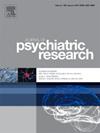Early improvement of psychopathological symptoms with add-on repetitive transcranial magnetic stimulation treatment as the key contributor to improving remission in schizophrenia
IF 3.2
2区 医学
Q1 PSYCHIATRY
引用次数: 0
Abstract
Early improvement with antipsychotic treatment is thought to be important in patients with first-episode schizophrenia(FES); however, no study has examined the contribution of add-on repetitive transcranial magnetic stimulation (rTMS). This study is aimed to investigate the efficacy and early improvement of rTMS in FES and to identify the relationship between initial symptom reduction and late response. A total of 105 patients with FES were randomly assigned to two groups: active rTMS group (n = 60) and sham rTMS group (n = 45), with existing olanzapine (10–20 mg/day) combined with 20 sessions of 1Hz active/sham rTMS over the right orbitofrontal cortex (20min/session, 5times/week). The Positive and Negative Syndrome Scale(PANSS) was used as the main tool to evaluate the clinical symptoms of patients at baseline, week-2, and week-8. Early improvement was defined as an improvement in PANSS total score at week 2. Significant improvements in clinical symptoms(PANSS total, positive[PANSS-P], negative[PANSS-N], and general psychopathological symptoms[PANSS-G]) were found in both the rTMS and sham groups. Moreover, a repeated-measures general linear model showed the decrease from baseline in PANSS-total(group × visit, F = 9.906, p < 0.001), PANSS-N(group × visit, F = 4.108, p = 0.020), and PANSS-G(group × visit, F = 12.095, p < 0.001) at week 8 were significant in the active rTMS group but not in the sham group. The active rTMS group had significant early improvements in PANSS-total(z = 3.348, p = 0.001), PANSS-N(z = 2.222, p = 0.026) and PANSS-G(z = 2.624, p = 0.009), compared with the sham group. Early improvements were significantly related to the 8-week improvements. Add-on rTMS treatment as a supplement to antipsychotics could potentially increase the efficacy of early improvements and improve the ultimate remission in patients with FES.
Clinical trial registration
Chinese Clinical Trial Register Center (http://www.chictr.org.cn/)
Identifier
ChiCTR2000041106.
Registered
December 17, 2020.
附加重复经颅磁刺激治疗的精神病理症状的早期改善是改善精神分裂症缓解的关键因素
抗精神病药物治疗的早期改善被认为对首发精神分裂症(FES)患者很重要;然而,没有研究检查附加的重复经颅磁刺激(rTMS)的贡献。本研究旨在探讨rTMS对FES的疗效和早期改善,并确定初始症状减轻与晚期反应的关系。105例FES患者被随机分为两组:活性rTMS组(n = 60)和假性rTMS组(n = 45),既有奥氮平(10 - 20mg /天),同时在右侧眶额叶皮层进行20次1Hz活性/假性rTMS(20分钟/次,5次/周)。采用阳性和阴性症状量表(PANSS)作为主要工具评估患者在基线、第2周和第8周的临床症状。早期改善定义为第2周PANSS总分的改善。rTMS组和假手术组的临床症状(PANSS total,阳性[PANSS- p],阴性[PANSS- n]和一般精神病理症状[PANSS- g])均有显著改善。此外,重复测量的一般线性模型显示PANSS-total(组×就诊,F = 9.906, p <;0.001), PANSS-N(集团×访问,F = 4.108, p = 0.020),和PANSS-G(集团×访问,F = 12.095, p & lt;0.001),在第8周时,活跃rTMS组有显著性差异,而假手术组无显著性差异。与假手术组相比,主动rTMS组PANSS-total(z = 3.348, p = 0.001)、PANSS-N(z = 2.222, p = 0.026)和PANSS-G(z = 2.624, p = 0.009)的早期改善均有显著性意义。早期的改善与8周的改善显著相关。附加rTMS治疗作为抗精神病药物的补充可能潜在地增加FES患者早期改善的疗效并改善最终缓解。临床试验注册中国临床试验注册中心(http://www.chictr.org.cn/)IdentifierChiCTR2000041106.RegisteredDecember, 2020。
本文章由计算机程序翻译,如有差异,请以英文原文为准。
求助全文
约1分钟内获得全文
求助全文
来源期刊

Journal of psychiatric research
医学-精神病学
CiteScore
7.30
自引率
2.10%
发文量
622
审稿时长
130 days
期刊介绍:
Founded in 1961 to report on the latest work in psychiatry and cognate disciplines, the Journal of Psychiatric Research is dedicated to innovative and timely studies of four important areas of research:
(1) clinical studies of all disciplines relating to psychiatric illness, as well as normal human behaviour, including biochemical, physiological, genetic, environmental, social, psychological and epidemiological factors;
(2) basic studies pertaining to psychiatry in such fields as neuropsychopharmacology, neuroendocrinology, electrophysiology, genetics, experimental psychology and epidemiology;
(3) the growing application of clinical laboratory techniques in psychiatry, including imagery and spectroscopy of the brain, molecular biology and computer sciences;
 求助内容:
求助内容: 应助结果提醒方式:
应助结果提醒方式:


